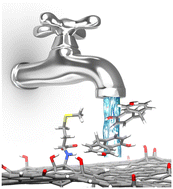Amino acid-driven adsorption of emerging contaminants in water by modified graphene oxide nanosheets†
Abstract
Graphene oxide nanosheets have shown promising adsorption properties toward emerging organic contaminants in drinking water. Here, we report a family of graphene oxide nanosheets covalently modified with amino acids and the study on their adsorption properties toward a mixture of selected contaminants, including pharmaceuticals, additives, and dyes. Graphene oxides modified with L-glutamic acid and L-methionine (GO-Glu and GO-Met) were synthesized and purified with a scalable and fast synthetic and purification procedure, and their structure was studied by combined X-ray photoelectron spectroscopy and elemental analysis. An amino acid loading of about 5% and a slight reduction (from 27% down to 14–20% oxygen) were found and associated with the adsorption selectivity. They were compared to unmodified GO, reduced GO (rGO), GO-lysine, and to the reference sample GO-NaOH. Each type of modified GO possesses a higher adsorption capacity toward bisphenol A (BPA), benzophenone-4 (BP4), and carbamazepine (CBZ) than standard GO and rGO, and the adsorption occurred within the first hour of contact time. The maximum adsorption capacity (estimated from the adsorption isotherms) was strictly related to the amino acid loading. Accordingly, molecular dynamics simulations highlighted higher interaction energies for the modified GOs than unmodified GO, as a result of higher van der Waals and hydrophobic interactions between the contaminants and the amino acid side chains on the nanosheet surface.

- This article is part of the themed collections: Environmental Science: Water Research & Technology Recent HOT Articles and Recent Open Access Articles


 Please wait while we load your content...
Please wait while we load your content...